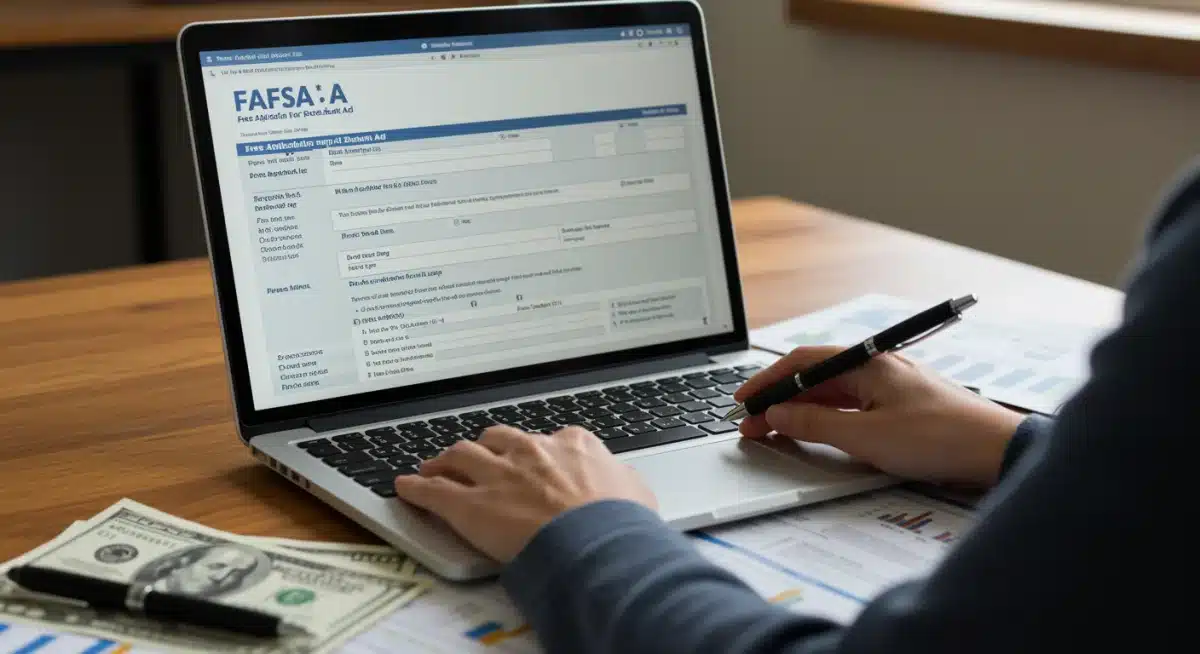Unlocking Federal Pell Grants: 2025 Application Guide

Applying for Federal Pell Grants in 2025 can secure up to $7,395 for eligible students, offering a vital pathway to higher education without the burden of repayment.
Navigating the landscape of college funding can often feel overwhelming, but understanding programs like the Federal Pell Grants 2025 is a crucial first step. This guide is designed to demystify the application process, helping prospective students secure up to $7,395 to finance their education without incurring debt. Let’s explore how to unlock this significant financial aid opportunity.
Understanding the Federal Pell Grant: What It Is and Who Qualifies
The Federal Pell Grant stands as a cornerstone of federal student aid, providing need-based funds to undergraduate students who are pursuing their first bachelor’s degree. Unlike loans, Pell Grants do not need to be repaid, making them an invaluable resource for many students. For the 2025-2026 award year, eligible students could receive up to $7,395, a figure that truly makes a difference in covering tuition, fees, and living expenses.
Eligibility for a Pell Grant is primarily determined by a student’s demonstrated financial need, as calculated through the Free Application for Federal Student Aid (FAFSA). Several factors play into this calculation, including your family’s income and assets, family size, and the cost of attendance at your chosen institution. It’s not solely about income; a holistic view of your financial situation is taken into account to ensure those who need it most receive support.
Key Eligibility Criteria for 2025
- Be an undergraduate student enrolled in an eligible program.
- Demonstrate exceptional financial need.
- Be a U.S. citizen or eligible non-citizen.
- Maintain satisfactory academic progress once enrolled.
Beyond these core requirements, students must also not be in default on any federal student loans or owe a refund on a federal student grant. The grant is designed to support students who are truly committed to their education but face financial barriers. Understanding these criteria early can help you prepare for a successful application.
In essence, the Federal Pell Grant is a federal commitment to making higher education accessible. It’s a foundational piece of financial aid that can significantly reduce the out-of-pocket costs for college, allowing students to focus more on their studies and less on financial burdens. This grant is a direct investment in your future, paving the way for academic and professional success.
The FAFSA: Your Gateway to Pell Grants for 2025
The Free Application for Federal Student Aid, or FAFSA, is the single most critical document for accessing Federal Pell Grants for 2025. This form collects detailed financial and demographic information to determine your eligibility for various federal, state, and institutional aid programs. Completing it accurately and on time is paramount to maximizing your financial aid opportunities, including the Pell Grant.
The FAFSA becomes available annually on October 1st for the upcoming academic year. For the 2025-2026 academic year, students should aim to complete the FAFSA as close to October 1, 2024, as possible. Many aid programs, including some state and institutional grants, operate on a first-come, first-served basis, meaning earlier submission can lead to more aid.
Gathering Necessary Documents Before You Begin
Before you even start filling out the FAFSA, it’s crucial to gather all the required documents. This preparation can streamline the process and prevent delays. Having everything organized will save you time and reduce the likelihood of errors.
- Your Social Security number (and parents’ if dependent).
- Your Alien Registration number if you are not a U.S. citizen.
- Federal income tax returns, W-2s, and other records of money earned.
- Bank statements and records of investments (if applicable).
- Records of untaxed income (if applicable).
Remember that for the 2025-2026 FAFSA, you will typically use your 2023 tax information. This is referred to as the ‘prior-prior year’ data, making the application process simpler as tax information is usually already filed. Utilizing the IRS Data Retrieval Tool (DRT) within the FAFSA is highly recommended, as it securely transfers your tax information directly from the IRS, reducing errors and saving time.

Completing the FAFSA might seem daunting, but it’s a vital step towards securing financial aid. Take your time, gather your documents, and don’t hesitate to seek assistance from your high school counselor or college financial aid office if you encounter any difficulties.
Step-by-Step Application Process for the 2025 Pell Grant
Applying for the Federal Pell Grant is intrinsically linked to completing the FAFSA. This step-by-step guide will walk you through the process, ensuring you cover all bases for the 2025-2026 academic year. Diligence in each step is key to a successful application and maximizing your potential award.
The entire process is designed to be user-friendly, especially with the enhancements introduced in recent years. Online submission is the most efficient method, allowing for quicker processing and fewer errors compared to paper applications. Begin by creating an FSA ID, which serves as your electronic signature for federal student aid documents.
Detailed Application Steps
The following steps outline the typical journey for applying for a Pell Grant:
- Create an FSA ID: Both the student and one parent (if dependent) will need an FSA ID. This is your username and password for federal student aid websites.
- Gather Required Documents: As mentioned, collect your Social Security number, tax returns, W-2s, and financial records.
- Complete the FAFSA Online: Visit the official Federal Student Aid website (StudentAid.gov) to begin. Fill out all sections accurately, utilizing the IRS Data Retrieval Tool if possible.
- List Schools: Include all colleges you are considering on your FAFSA. Each school will receive your FAFSA information and can then prepare a financial aid package for you.
- Review and Submit: Carefully review all information before submitting. Errors can delay processing. Electronically sign with your FSA ID.
- Receive Student Aid Report (SAR): After submission, you’ll receive a Student Aid Report (SAR) which summarizes your FAFSA data. Review it for accuracy and make corrections if needed.
- Receive Financial Aid Offer: Each school you listed will send you a financial aid offer detailing the aid you’re eligible for, including any Pell Grant award.
It’s important to note that the amount of your Pell Grant can vary based on your Expected Family Contribution (EFC) and your enrollment status (full-time or part-time). The maximum award for 2025-2026 is projected to be $7,395, but your actual award will be determined by your specific circumstances.
By following these steps meticulously, you significantly increase your chances of securing the Federal Pell Grant and other valuable financial aid, making your educational aspirations more attainable.
Maximizing Your Pell Grant: Tips for 2025 Applicants
While the Pell Grant is needs-based, there are strategies applicants can employ to ensure they receive the maximum possible award for the 2025-2026 academic year. Understanding how your financial situation is assessed and acting proactively can make a substantial difference in the aid you receive.
One of the most critical aspects is the accuracy of your FAFSA submission. Any errors, even minor ones, can lead to delays or a miscalculation of your eligibility. Double-checking all figures and ensuring consistency with your tax documents is paramount. The IRS Data Retrieval Tool is an excellent resource for this, as it reduces manual entry errors.
Strategic Tips for a Higher Award
- Submit FAFSA Early: While Pell Grants are not typically first-come, first-served, other aid programs often are. Submitting early ensures you’re considered for all available aid.
- Understand Your EFC (Expected Family Contribution): The EFC is a key factor. While you can’t drastically change your financial situation overnight, understanding how assets and income are weighed can inform long-term financial planning.
- Report Special Circumstances: If your family’s financial situation has changed significantly since the tax year used for FAFSA (e.g., job loss, medical expenses), contact your college’s financial aid office. They may be able to make professional judgment adjustments.
- Enroll Full-Time: Pell Grant awards are typically higher for full-time students. If feasible, consider enrolling full-time to maximize your award.
- Avoid Defaulting on Previous Loans: If you or a parent has defaulted on a federal student loan, it will impact your eligibility for federal aid, including Pell Grants.
It’s also beneficial to maintain strong academic performance. While satisfactory academic progress is a requirement to continue receiving Pell Grants, consistently performing well can open doors to other merit-based scholarships that can supplement your federal aid. Your academic record, combined with financial need, presents a compelling case for support.
By being strategic and meticulous in your application process, you can effectively maximize the Federal Pell Grant and other financial aid opportunities, helping to fund your education without excessive personal expense or debt.
What Happens After FAFSA Submission: SAR and Award Letters
Once you’ve submitted your FAFSA for the 2025-2026 academic year, the process shifts from application to evaluation and notification. Understanding what to expect during this phase is crucial for managing your college finances effectively. The period following submission involves receiving important documents that detail your eligibility and aid offers.
The first document you’ll receive is the Student Aid Report (SAR). This report summarizes the data you provided on your FAFSA. It’s essential to review your SAR thoroughly for any inaccuracies. If you find errors, you must correct them promptly, as these corrections can impact your eligibility and the amount of aid you receive.
Interpreting Your Student Aid Report (SAR)
Your SAR will contain your Expected Family Contribution (EFC), which is a key number that colleges use to determine your financial need. The EFC is not the amount of money your family will have to pay for college, nor is it the amount of federal student aid you will receive. It’s an index number used by financial aid offices to calculate your eligibility for various aid programs, including the Pell Grant.
- EFC Calculation: Understand how your EFC was calculated and what factors influenced it.
- Pell Grant Eligibility: Your SAR will indicate whether you are eligible for a Pell Grant and, if so, an estimated amount.
- Corrections: If necessary, learn how to make corrections to your FAFSA data through the StudentAid.gov website.
Following the SAR, colleges you listed on your FAFSA will begin sending out financial aid offer letters. These letters detail the specific types and amounts of aid they are offering you, which can include Pell Grants, other federal grants, state grants, institutional scholarships, and federal student loans. Comparing these offers from different schools is vital to make an informed decision.
The financial aid offer letter is your comprehensive overview of how much assistance you can receive. Pay close attention to the breakdown of grants (free money) versus loans (money that must be repaid) and evaluate the net cost of attendance at each institution. This stage is about making strategic choices based on the aid you’ve been awarded.
Common Mistakes to Avoid When Applying for Pell Grants
Applying for financial aid can be a complex process, and even minor missteps can impact your eligibility for a Federal Pell Grant. Being aware of common mistakes can help you navigate the 2025 application cycle more smoothly and secure the funding you need for your education. Prevention is always better than correction, especially when it comes to financial aid deadlines.
One of the most frequent errors is simply missing deadlines. While federal deadlines for the FAFSA are often generous, state and institutional deadlines can be much earlier. Missing these can cost you access to significant state-specific grants or institutional scholarships, which often complement federal aid like the Pell Grant.
Pitfalls to Sidestep for a Successful Application
- Late FAFSA Submission: Always aim to submit your FAFSA as early as possible, ideally shortly after October 1st.
- Inaccurate Information: Double-check all financial and personal data. Discrepancies can lead to delays or requests for verification.
- Not Using the IRS Data Retrieval Tool (DRT): The DRT minimizes errors and simplifies the process of transferring tax information.
- Forgetting to Sign the FAFSA: Both the student and a parent (if dependent) must electronically sign the FAFSA with their FSA IDs.
- Not Reporting Special Circumstances: If your financial situation has changed dramatically, contact your financial aid office. They can often provide flexibility.
- Ignoring the Student Aid Report (SAR): Review your SAR for accuracy and make necessary corrections immediately.
Another common mistake is assuming you won’t qualify for aid and therefore not applying. Many students underestimate their eligibility, especially for grants like the Pell Grant, which is based on demonstrated financial need. Even if you think your family income is too high, it’s always worth completing the FAFSA to see what aid you might be eligible for.
By being diligent and avoiding these common pitfalls, you can significantly improve your chances of a successful Pell Grant application, ensuring you receive the financial support necessary to pursue your academic goals.
Beyond the Pell Grant: Other Financial Aid Options for 2025
While the Federal Pell Grant is a cornerstone of financial aid for many students, it’s important to remember that it’s often just one component of a larger financial aid package. For the 2025-2026 academic year, exploring other avenues of financial assistance can significantly reduce your overall college costs and minimize the need for student loans.
Several types of aid exist beyond the Pell Grant, each with its own eligibility criteria and application process. These can include other federal grants, state grants, institutional scholarships, private scholarships, and federal student loans. A comprehensive approach to financial aid involves researching and applying for as many relevant options as possible.
Exploring Additional Aid Opportunities
- Federal Supplemental Educational Opportunity Grant (FSEOG): Another federal grant for undergraduates with exceptional financial need. Funds are limited, so apply early.
- Teacher Education Assistance for College and Higher Education (TEACH) Grant: For students committed to teaching in high-need fields in low-income schools. Requires a service obligation.
- Iraq and Afghanistan Service Grant: For students whose parent or guardian died as a result of military service in Iraq or Afghanistan after 9/11.
- State Grants: Many states offer their own grant programs. Check with your state’s higher education agency for specific details and deadlines.
- Institutional Scholarships: Colleges and universities award their own scholarships based on merit, need, or specific criteria.
- Private Scholarships: Offered by various organizations, foundations, and businesses. Utilize scholarship search engines and your high school guidance counselor.
- Federal Student Loans: While grants are preferable, federal loans (Stafford Loans, PLUS Loans) offer favorable terms compared to private loans and are often part of a financial aid package.
It’s crucial to understand the difference between ‘gift aid’ (grants and scholarships that don’t need to be repaid) and ‘self-help aid’ (loans and work-study programs). Prioritize gift aid whenever possible to reduce your overall debt burden. Your college’s financial aid office is an invaluable resource for understanding all the options available to you.
By proactively seeking out and applying for diverse financial aid options, you can build a robust funding plan that makes your educational dreams a financially sustainable reality in 2025 and beyond.
| Key Aspect | Brief Description |
|---|---|
| Pell Grant Max 2025 | Up to $7,395 for eligible undergraduate students. |
| FAFSA Importance | Mandatory application for all federal aid, including Pell Grants. |
| Eligibility Key Factor | Primarily based on demonstrated financial need (EFC). |
| Application Strategy | Submit FAFSA early, review SAR, and apply for other aid. |
Frequently Asked Questions About Federal Pell Grants
For the 2025-2026 academic year, the maximum Federal Pell Grant award for eligible students is projected to be $7,395. This amount is subject to change based on congressional appropriations but serves as a strong estimate for planning purposes. Your actual award will depend on your demonstrated financial need and enrollment status.
No, a Federal Pell Grant is a form of financial aid that does not typically need to be repaid. It is designed to help undergraduate students with exceptional financial need pursue higher education. However, there are very specific circumstances where you might have to repay, such as withdrawing from school early.
You should complete the Free Application for Federal Student Aid (FAFSA) as soon as possible after October 1, 2024, for the 2025-2026 academic year. While federal deadlines are often later, many state and institutional aid programs have earlier deadlines, and some funds are awarded on a first-come, first-served basis.
Yes, you can receive a Federal Pell Grant if you are attending school part-time. However, the amount of your Pell Grant will be adjusted based on your enrollment status. Full-time students generally receive the maximum award, while part-time students receive a prorated amount corresponding to their credit load.
If your family’s financial situation changes significantly after you submit the FAFSA (e.g., job loss, medical expenses, divorce), contact the financial aid office at your college. They have the discretion to make professional judgment adjustments to your FAFSA data, potentially increasing your eligibility for aid.
Conclusion
Securing a Federal Pell Grant for 2025 is a transformative step toward achieving your educational aspirations without the burden of overwhelming debt. By diligently completing the FAFSA, understanding the eligibility criteria, and proactively exploring all available financial aid options, students can unlock significant funding to support their college journey. The maximum award of up to $7,395 represents a profound opportunity, emphasizing the importance of a well-informed and timely application. Remember, your education is an investment, and the Pell Grant is a powerful tool to make that investment a reality.





